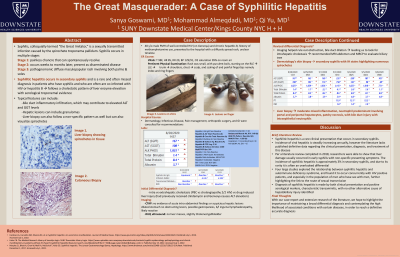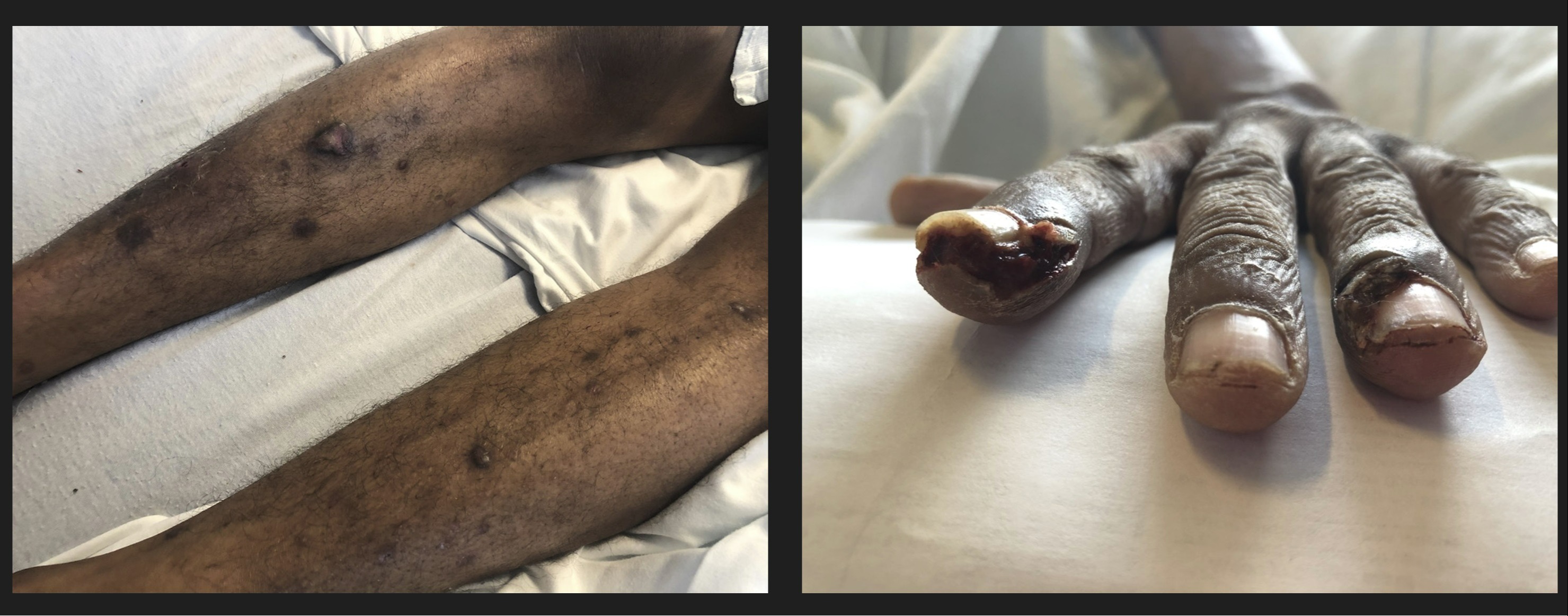Back


Poster Session A - Sunday Afternoon
Category: Liver
A0545 - The Great Masquerader: A Case of Syphilitic Hepatitis
Sunday, October 23, 2022
5:00 PM – 7:00 PM ET
Location: Crown Ballroom

Has Audio

Sanya Goswami, MD
NYC H+H Kings County/SUNY Downstate Medical Center
Brookyln, NY
Presenting Author(s)
Sanya Goswami, MD1, Mohammad Almeqdadi, MD2, Qi Yu, MD3
1NYC H+H Kings County/SUNY Downstate Medical Center, Brookyln, NY; 2NYC H+H Kings County/SUNY Downstate Medical Center, Brooklyn, NY; 3NYC Health + Hospitals/King's County, SUNY Downstate, Brookyn, NY
Introduction: Syphilis, colloquially termed “the Great Imitator,” is a sexually transmitted infection caused by the spirochete treponema pallidum. Syphilis occurs in multiple stages. Tertiary syphilis occurs years after inoculation and presents with chronic granulomas, cardiovascular, and neurologic manifestations. Syphilitic hepatitis is a rare and often missed diagnosis in patients who have syphilis and who are often are co-infected with HIV or hepatitis B.
Case Description/Methods: The diagnosis is made by both clinical presentations and positive serological markers, characteristic transaminitis, with no other alternative cause of hepatobiliary injury identified. Here, we highlight a case of an undomiciled 40-year-old male with HIV (on Genvoya) and chronic hepatitis B, who presented with tachycardia to 107. Physical examination was remarkable for a diffusely spread rash with erythema on the bilateral lower extremities, a small purulent boil on the right shin, left index finger and dry, itchy, distinct raised purple lesions on the scalp, eyebrows, upper and lower extremities, back, and shoulders. Laboratory findings were remarkable for a severely elevated alkaline phosphatase, mild transaminitis, and elevated total bilirubin, with negative pertinent imaging including a right upper quadrant sonogram, CT scan of the abdomen, and MRCP. Extensive additional work-up revealed elevated VDRL titers. Both a skin and liver biopsy were completed. Immunohistochemical stain of shave biopsy of a verrucous plaque on the scalp vertex and an excoriated papule of the left neck highlighted numerous spirochetes. Liver biopsy revealed hepatocellular necrosis with moderate mixed inflammation involving the portal tract and periportal hepatocytes, with immunohistochemical marker for spirochetes negative for organisms. However, given the patient’s clinical history of secondary syphilis involving the skin and lab abnormalities, it raised the differential diagnosis of syphilitic hepatitis.
Discussion: With our case report and extensive research of the literature, we hope to shed light on the importance of certain infections, even those in decline, on the differential. Additionally, contemplation of coexisting infections often helps to contribute to diagnoses not otherwise common. Because of how rarely seen syphilitic hepatitis is, it is often a missed diagnosis, but we are hopeful our case report helps physicians with patients with similar presentations, especially patients with otherwise unexplained high alkaline phosphatase levels.

Disclosures:
Sanya Goswami, MD1, Mohammad Almeqdadi, MD2, Qi Yu, MD3. A0545 - The Great Masquerader: A Case of Syphilitic Hepatitis, ACG 2022 Annual Scientific Meeting Abstracts. Charlotte, NC: American College of Gastroenterology.
1NYC H+H Kings County/SUNY Downstate Medical Center, Brookyln, NY; 2NYC H+H Kings County/SUNY Downstate Medical Center, Brooklyn, NY; 3NYC Health + Hospitals/King's County, SUNY Downstate, Brookyn, NY
Introduction: Syphilis, colloquially termed “the Great Imitator,” is a sexually transmitted infection caused by the spirochete treponema pallidum. Syphilis occurs in multiple stages. Tertiary syphilis occurs years after inoculation and presents with chronic granulomas, cardiovascular, and neurologic manifestations. Syphilitic hepatitis is a rare and often missed diagnosis in patients who have syphilis and who are often are co-infected with HIV or hepatitis B.
Case Description/Methods: The diagnosis is made by both clinical presentations and positive serological markers, characteristic transaminitis, with no other alternative cause of hepatobiliary injury identified. Here, we highlight a case of an undomiciled 40-year-old male with HIV (on Genvoya) and chronic hepatitis B, who presented with tachycardia to 107. Physical examination was remarkable for a diffusely spread rash with erythema on the bilateral lower extremities, a small purulent boil on the right shin, left index finger and dry, itchy, distinct raised purple lesions on the scalp, eyebrows, upper and lower extremities, back, and shoulders. Laboratory findings were remarkable for a severely elevated alkaline phosphatase, mild transaminitis, and elevated total bilirubin, with negative pertinent imaging including a right upper quadrant sonogram, CT scan of the abdomen, and MRCP. Extensive additional work-up revealed elevated VDRL titers. Both a skin and liver biopsy were completed. Immunohistochemical stain of shave biopsy of a verrucous plaque on the scalp vertex and an excoriated papule of the left neck highlighted numerous spirochetes. Liver biopsy revealed hepatocellular necrosis with moderate mixed inflammation involving the portal tract and periportal hepatocytes, with immunohistochemical marker for spirochetes negative for organisms. However, given the patient’s clinical history of secondary syphilis involving the skin and lab abnormalities, it raised the differential diagnosis of syphilitic hepatitis.
Discussion: With our case report and extensive research of the literature, we hope to shed light on the importance of certain infections, even those in decline, on the differential. Additionally, contemplation of coexisting infections often helps to contribute to diagnoses not otherwise common. Because of how rarely seen syphilitic hepatitis is, it is often a missed diagnosis, but we are hopeful our case report helps physicians with patients with similar presentations, especially patients with otherwise unexplained high alkaline phosphatase levels.

Figure: Image 1. Skin Findings
Disclosures:
Sanya Goswami indicated no relevant financial relationships.
Mohammad Almeqdadi indicated no relevant financial relationships.
Qi Yu indicated no relevant financial relationships.
Sanya Goswami, MD1, Mohammad Almeqdadi, MD2, Qi Yu, MD3. A0545 - The Great Masquerader: A Case of Syphilitic Hepatitis, ACG 2022 Annual Scientific Meeting Abstracts. Charlotte, NC: American College of Gastroenterology.

